Standard [CURRENT]
ASTM D 5923:2025
Standard Guide for Selection of Kriging Methods in Geostatistical Site Investigations
- German title
- Auswahl von Kriging-Methoden bei geostatistischen Standortuntersuchungen
- Publication date
- 2025
- Original language
- English
- Pages
- 4
- Publication date
- 2025
- Original language
- English
- Pages
- 4
- DOI
- https://dx.doi.org/10.1520/D5923-25
Product information on this site:
Quick delivery via download or delivery service
Buy securely with a credit card or pay upon receipt of invoice
All transactions are encrypted
Short description
1.1 This guide covers recommendations for selecting appropriate kriging methods based on study objectives, exploratory data analysis, and analysis of spatial variation. 1.2 This guide considers commonly used forms of kriging, including ordinary kriging, simple kriging, lognormal kriging, universal kriging, and indicator kriging. Multivariate, space-time, and other less-frequently used kriging methods are not discussed; however, this is not intended to reflect any judgement as to the validity of these methods. 1.3 This guide describes conditions for which kriging methods are not appropriate and for which geostatistical simulations approaches should be used. 1.4 This guide does not discuss non-geostatistical alternatives to kriging, such as splines or inverse-distance techniques. 1.5 This guide does not discuss the basic principles of kriging. Introductions to geostatistics and kriging may be found in numerous texts including Refs ( 1- 8 ) . 2 A review of kriging methods is given in Ref. ( 9 and 10 ) . 1.6 This standard does not purport to address all of the safety concerns, if any, associated with its use. It is the responsibility of the user of this standard to establish appropriate safety, health, and environmental practices and determine the applicability of regulatory limitations prior to use. 1.7 This guide offers an organized collection of information or a series of options and does not recommend a specific course of action. This document cannot replace education or experience and should be used in conjunction with professional judgment. Not all aspects of this guide may be applicable in all circumstances. This ASTM standard is not intended to represent or replace the standard of care by which the adequacy of a given professional service must be judged, nor should this document be applied without consideration of a project's many unique aspects. The word "Standard" in the title of this document means only that the document has been approved through the ASTM consensus process. 1.8 This international standard was developed in accordance with internationally recognized principles on standardization established in the Decision on Principles for the Development of International Standards, Guides and Recommendations issued by the World Trade Organization Technical Barriers to Trade (TBT) Committee.
ICS
07.060
DOI
https://dx.doi.org/10.1520/D5923-25
Also available in
Loading recommended items...
Loading recommended items...
Loading recommended items...
Loading recommended items...

